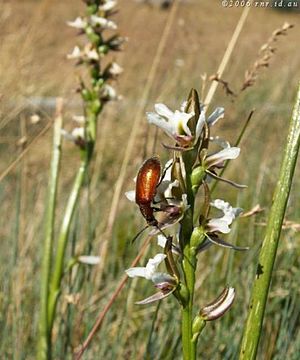Buffalo leek-orchid facts for kids
Quick facts for kids Buffalo leek-orchid |
|
|---|---|
 |
|
| Prasophyllum suttonii growing on Mount Buffalo | |
| Conservation status | |
| Scientific classification |
The Prasophyllum suttonii, also known as the mauve leek orchid or Buffalo leek-orchid, is a special type of orchid. It grows only in the Australian Alps. Some experts believe this orchid only grows in Victoria and might even be extinct there. Others say it can still be found in New South Wales. This orchid has a single leaf shaped like a tube. It can grow up to thirty-five white flowers. These flowers often have pretty purple or mauve marks.
Contents
About the Buffalo Leek Orchid
According to the National Herbarium of New South Wales, the Prasophyllum suttonii is a plant that grows from an underground tuber. It is a perennial plant, meaning it lives for more than two years. It also loses its leaves each year, which makes it deciduous. The plant has one tube-shaped leaf that can be up to 200 mm (8 in) long.
What the Flowers Look Like
The Buffalo leek orchid can have up to thirty-five sweet-smelling flowers. These flowers are a clear white color with purple or mauve spots. They grow close together on a stem that can reach 400 mm (20 in) tall. Like other orchids in its group, its flowers are upside down. This means the special lip-like part, called the labellum, is above the central part, called the column.
The top petal, called the dorsal sepal, is shaped like an egg or a spear. It can be up to 9 mm (0.4 in) long. The side petals, called lateral sepals, are up to 7 mm (0.3 in) long. They are usually separate but sometimes joined by a thin layer. The other petals are shaped like a spatula and are up to 8 mm (0.3 in) long.
The labellum is broad and shaped like an egg or spear. It is about 8 mm (0.3 in) long and 4 mm (0.2 in) wide. It bends sharply upwards in the middle, going above the side sepals. The edges of the labellum are crinkled or folded. There is also a green, grooved callus (a thickened part) along its center. These orchids usually bloom from January to March.
Differences in Descriptions
Some botanists, like those at the Royal Botanic Gardens Victoria and David Jones, describe this orchid a bit differently. They say it has fewer flowers on its stem. They also note that most parts of the flower are smaller. They believe it blooms earlier, in December.
Naming the Orchid
The Prasophyllum suttonii was first officially described in 1912. This was done by two scientists, Richard Sanders Rogers and Bertha Rees. Their description was published in a scientific paper called Proceedings of the Royal Society of Victoria. The plant they studied was found on Mount Buffalo.
The second part of its name, suttonii, honors Charles Stanford Sutton. He was a doctor and also loved studying plants. He was a long-time member of the Field Naturalists Club of Victoria.
Where it Lives and Grows
The mauve leek orchid prefers to grow in wet, marshy areas. It can be found in alpine and subalpine grasslands and heathlands. Most of these areas are in the Kosciuszko National Park in New South Wales.
However, authorities in Victoria believe this orchid only grows in their state. They list it as "Presumed Extinct" there. This is because no new plants have been found in Victoria since 1902.
Protecting the Orchid
The Buffalo leek-orchid is not listed under a big Australian law called the Environment Protection and Biodiversity Conservation Act 1999 (EPBC) Act. This act helps protect many endangered plants and animals.
But in Victoria, the orchid is listed as "Threatened" under their own law, the Flora and Fauna Guarantee Act 1988. This means it is considered at risk in Victoria.


